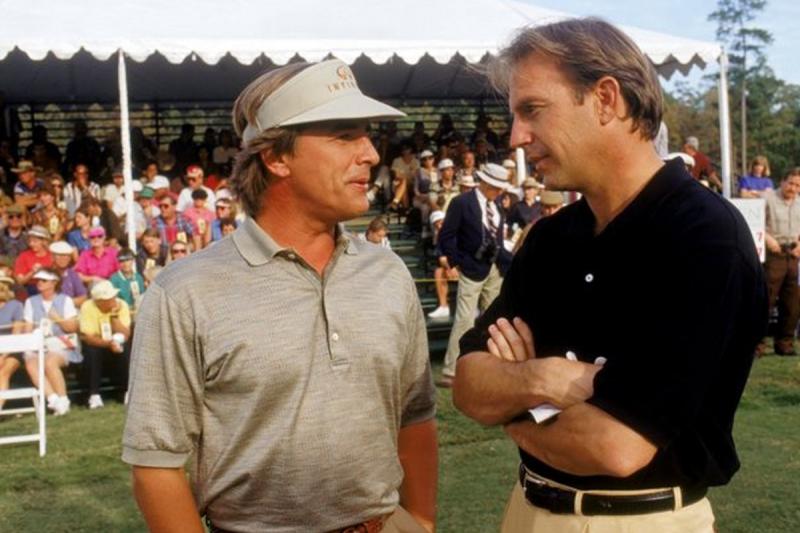If you are old enough to remember the golf movie “Tin Cup,” you might recall a bet between Roy McAvoy (Kevin Costner) and David Simms (Don Johnson). Both were constantly trying to impress their love interest, Dr. Molly Griswold (Renee Russo).
Having drinks outside the clubhouse and adjacent to the warmup driving range area, McAvoy bet Simms he could out-hit him in total distance with a five iron. He backed up the bet with his car as the payment. McAvoy went first and crushed his iron shot past the 225 sign, then turned to Simms with some trash talk about the winning shot. Simms calmly aimed his shot toward the paved road leading into the club and hit his five iron shot, which bounced down the road and stopped about a half mile away. In the next scene, Simms was driving McAvoy’s car out of the parking lot, with Dr. Griswold sitting beside him. Lesson learned. Sometimes a paved road or cart path helps; sometimes it hurts.
Some people say that art imitates life, and the next couple of golf stories - one forward and one in reverse, might bear that out. First, the forward story is about the longest drive on record in a PGA Tour event. Who would you think holds the record: Tiger Woods, Jack Nicklaus, Dustin Johnson or Sam Snead? As a clue, I will tell you the longest drive in PGA history was 787 yards. Well the answer is Carl Cooper, who teed it up on the third hole at the 1992 H.E.B. Texas Open which was played at San Antonio’s Oak Hills Country Club. Cooper pulled out an oversized driver and let it rip on the 456-yard hole and pushed his tee shot to the right side of the fairway. It went an estimated 300 yards before it hit the paved cart path numerous times while travelling downhill. It rolled to a stop against a chain-link fence, an estimated 787 yards from the tee.
Given a free drop, Cooper used a four iron and eight iron to get back near the third green, then chipped and two-putted for a bogey, six. In a cruel twist of fate, he missed the cut by two strokes. Pro golfer Mark Witt had a reverse twist of fate in the 1991 Ben Hogan Knoxville Open, played at Willow Creek Country Club. Later called the “boomerang” tee shot, Witt hit his drive on the 375 yard par four, seventeenth hole, about 300 yards, but pushed it to the left of the fairway. His ball rolled onto the hillside (paved) entrance rode to the course and began to roll backward down the hill toward the tee box. Two hundred-fifty yards later, it stopped about 50 yards from the tee.
Unfazed by the boomerang drive, Witt took a drop, then hit a three-wood back near the green, chipped up and one-putted for a bogey (no mention of how he finished).
19th hole trivia
How do you measure up, excluding a paved road or car path?
- According to TrackMan stats taken from the PGA Tour in 2014, “the average carry (the distance a ball travels in the air) of a shot hit with a driver by a Tour player was 275 yards. An average 3-wood shot carried 243 yards and the average 5-wood carried 230 yards. The typical carry for a 3-iron shot was 212 yards, for a 4-iron 203, for a 5-iron 194, for a 6-iron 183, for a 7-iron 172, for an 8-iron 160, and for a 9-iron 148. The average PGA Tour pitching wedge shot carried 136 yards.”
- According to TrackMan stats taken from the LPGA Tour in 2014, “the average female professional’s driver carries 218 yards. Her 3-, 5- and 7-woods carry 195, 185 and 174 yards respectively. LPGA pros hit 4-irons an average of 169 yards, 5-irons 161, 6-irons 152, 7-irons 141, 8-irons 130, and 9-irons 119 yards. Typical pitching wedge shots total 107 yards.”
- The Movie Tin Cup was released in 1996 and just celebrated its 20 Anniversary. The movie cost $45 million to make and has grossed over $75 million.
- The 18th green nightmare, where McAvoy needs 12 shots to hole out, is based on a real-life incident. Gary McCord once needed a birdie to win a similar tournament and went for it. Sixteen shots later, he holed out.





















































